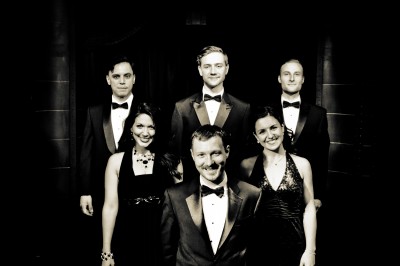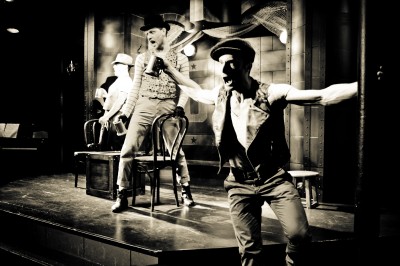A Kurt Weill Cabaret
Arrangements and Musical Direction by Jeremy Ramey
Choreography by Christie Kerr
Produced by Theo Ubique Cabaret Theatre
An incredible performance of some of the greatest pieces of musical theatre
Opening this week at Theo Ubique, A Kurt Weill Cabaret is one of the best chances you’ll ever have to see some of the Twentieth Century’s most beloved show tunes. This revue is modeled on Weill’s transition from a German avant-garde composer working with Bertolt Brecht to his period as a Broadway favorite collaborating with the likes of Ira Gershwin and Langston Hughes.

Entering Theo Ubique’s space in the No Exit Café feels like going back in time, an illusion aided by Bill Morey’s Act I costumes. Kellie Cundiff (soprano), Christopher Logan (baritone), Jordan Phelps (tenor), Michael Reyes (bass), and Jill Sesso (mezzo) appear as gritty early twentieth century tramps. The men’s angular facial hair and makeup put a skeletal accent on their cheekbones. I felt drawn into the dissolute Berlin cabaret of the 1920’s world before the music had even started.
Once Jeremy Ramey started playing his piano, it was clear that he was the sixth star of the show. Not only does he maintain the energy and mood of both acts despite their contrasting styles, but he has also balanced the sound perfectly. The singers have no microphones or amplifiers, but I could hear every word and every note on the piano. Ramey and director Fred Anzevino’s choice to include the entire half-hour long Mahagonny Songspiel provided the first act with a structure that, with a little imagination, incorporates the preceding three songs as prologues to the story. After all, anyone who longs for old Bilbao, where people danced under a perforated roof to the sound of shattering rum bottles, would love to move to the decadent town of Mahagonny.
This unusually plot-driven portion of the cabaret also gave the singers a chance to show their acting skills. Logan, Phelps, and Reyes stretch themselves across the entire playing space, shifting between sullen drunkenness and bursts of violence and lust. They’re the kind of guys who try to kill each other one minute and cuddle the next, and their harmonies give the first act most of its musical flavor. Cundiff and Sesso contort their faces in pitiful despondency. They wisely sing in their own voices instead of attempting to impersonate Lotte Lenya, and made her songs work for themselves. Although the singspiel doesn’t give much information about its protagonists, you can tell Anzevino and his cast know exactly who these characters are. Maya Fein’s rich, warm lighting design gives their world a passionate flavor while implying industrial pollution. Even though the show’s called a revue, every aspect works perfectly just for a production of the little Mahagonny.
 Act II contains the Broadway songs Weill wrote in America. I admit the songs actually written for cabarets are more my speed, but I can still tell the melodic pieces are done well. I was especially moved by Phelps and Sesso’s emotional and vocal strength in “Lonely House,” and “Trouble Man,” respectively. But the songs generally were melancholy, in contrast with the ribaldry of Act I, and I personally was glad for the two comic relief songs in the middle, “A Rhyme for Angela” and “Saga of Jenny.” Act II has a loose thematic progression, with a proclamation of America’s greatness near the beginning, followed by a rapid descent into lamentations on broken relationships. Not having to choreograph fights allowed Christine Kerr to put some dancing into the romantic songs, which are a lot more thrilling when seen up close than from the back of a proscenium theatre auditorium. Everybody’s make-up and costumes are much more clean-cut after the intermission; changing continents was like changing planets.
Act II contains the Broadway songs Weill wrote in America. I admit the songs actually written for cabarets are more my speed, but I can still tell the melodic pieces are done well. I was especially moved by Phelps and Sesso’s emotional and vocal strength in “Lonely House,” and “Trouble Man,” respectively. But the songs generally were melancholy, in contrast with the ribaldry of Act I, and I personally was glad for the two comic relief songs in the middle, “A Rhyme for Angela” and “Saga of Jenny.” Act II has a loose thematic progression, with a proclamation of America’s greatness near the beginning, followed by a rapid descent into lamentations on broken relationships. Not having to choreograph fights allowed Christine Kerr to put some dancing into the romantic songs, which are a lot more thrilling when seen up close than from the back of a proscenium theatre auditorium. Everybody’s make-up and costumes are much more clean-cut after the intermission; changing continents was like changing planets.
Regardless of which Weill you prefer, this show is not to be missed by any of his fans, or any fan of musicals generally. Considering what you get, the tickets are a bargain even at their top price. People nostalgic for the forties will have a great time, but you don’t really need to be familiar with the shows the Act II songs were taken from to enjoy them. Act I could have worked just by itself and will delight anyone who enjoys currently popular musicals like Cabaret or Urinetown and wants to discover that style’s roots. Together, there’s something for everyone and a chance to learn to appreciate a different side of Weill’s work.
Song list: all music by Kurt Weill
Act I
Bilbao Song – lyrics by Bertolt Brecht
The Tango Ballad – lyrics by Bertolt Brecht
Love Song – lyrics by Bertolt Brecht
Mahagonny Songspiel – lyrics by Bertolt Brecht
Act II
Stranger Here Myself -lyrics by Ogden Nash
The Nina, the Pinta, the Santa Maria – lyrics by Ira Gershwin
Westwind – lyrics by Ogden Nash
Speak Low – lyrics by Ogden Nash
Lonely House – lyrics by Langston Hughes
Stay Well – lyrics by Maxwell Anderson
A Rhyme for Angela – lyrics by Ira Gershwin
Saga of Jenny -lyrics by Ira Gershwin
Here I’ll Stay – lyrics by Alan Jay Lerner
Trouble Man – lyrics by Maxwell Anderson
September Song – lyrics by Maxwell Anderson
Lost in the Stars – lyrics by Maxwell Anderson
Mack the Knife -lyrics by Bertolt Brecht
Highly Recommended
Jacob Davis
Date Reviewed: September 22, 2014
At No Exit Cafe, 6970 North Glenwood Avenue, Call 800-595-4849, www.theo-u.com/, tickets $20-50 on Thursday and Sunday, $24-54 on Friday and Saturday,Thurs at 7:30 pm, Fri and Sat at 8:00 pm, Sunday at 7:00pm, and October 13 at 7:30 pm, Two hours with intermission, though October 19, 2014


